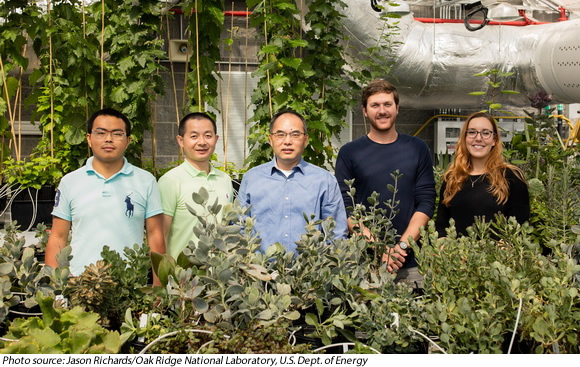
Genes from Drought Resistant Plants Could Help Create Water Efficient Crops
December 6, 2017| |
Scientists at the U.S Department of Energy's Oak Ridge National Laboratory (ORNL) have identified a common set of genes that enable different drought-resistant plants to survive in semi-arid conditions. The discovery could play a significant role in bioengineering and creating energy crops that are tolerant to water deficits.
The scientists are studying a variety of drought-resistant plants to unlock the mystery of crassulacean acid metabolism or CAM photosynthesis. The research team sequenced the genome of Kalanchoë fedtschenkoi, an emerging model for CAM genomics research because of its relatively small genome and amenability to genetic modification. The team investigated and compared the genomes of K. fedtschenkoi, Phalaenopsis equestris (orchid) and Ananas comosus (pineapple) using ORNL's Titan supercomputer.
They identified 60 genes that exhibited convergent evolution in CAM species, including convergent daytime and nighttime gene expression changes in 54 genes, as well as protein sequence convergence in six genes. The team discovered a novel variant of phosphoenolpyruvate carboxylase, or PEP, an important "worker" enzyme responsible for the nighttime fixation of carbon dioxide into malic acid, which is then converted back to carbon dioxide for photosynthesis during the day.

For more details about this study, read the ORNL News.
| |
Biotech Updates is a weekly newsletter of ISAAA, a not-for-profit organization. It is distributed for free to over 22,000 subscribers worldwide to inform them about the key developments in biosciences, especially in biotechnology. Your support will help us in our mission to feed the world with knowledge. You can help by donating as little as $10.
-
See more articles:
-
News from Around the World
- FAO: Urgent Action Needed to Combat Fast-spreading Pests and Diseases that Harm Food Security
- Plant and Animal Innovation Experts Discuss Practical Strategies to Advance Plant Breeding
- African Agri Researchers Trained on Science Communication
- Research Team from US, China, and France Releases Genome Sequence of Bottle Gourd
- Plant Biologist Wins the 2018 Breakthrough Prize in Life Sciences
- Genes from Drought Resistant Plants Could Help Create Water Efficient Crops
- Researchers Discover Gene for Flowering also Directs Root Growth in Wheat and Barley
- Study Shows that Golden Rice Could Benefit Bangladesh
- USDA FAS Releases Annual Agbiotech Report for Japan
- Glyphosate Gets 5-Year Renewal in the European Union
- European Science Academies Call for Urgent Action on Food and Nutrition Security
-
Research Highlights
- Arabidopsis Elongator Genes Enhance Disease Resistance in Strawberry
- miR172c and NNC1 Regulate Root Plastic Development in Response to Salt Stress in Soybean
-
Resources
- Biotech Country Facts and Trends
-
Plant
- CRISPR-Cas9 and TALENs Used to Generate Mutants for Studying Small RNA in Legumes
-
Read the latest: - Biotech Updates (December 17, 2025)
- Gene Editing Supplement (December 17, 2025)
- Gene Drive Supplement (February 22, 2023)
-
Subscribe to BU: - Share
- Tweet
